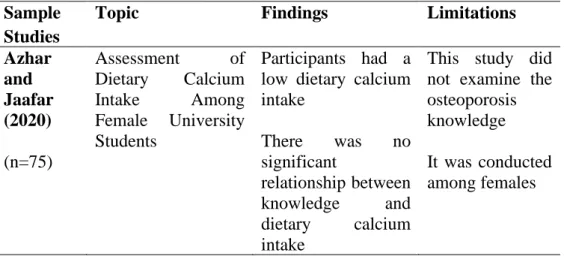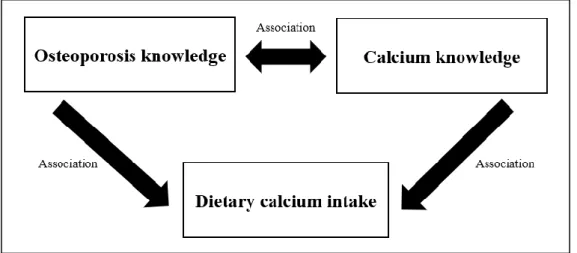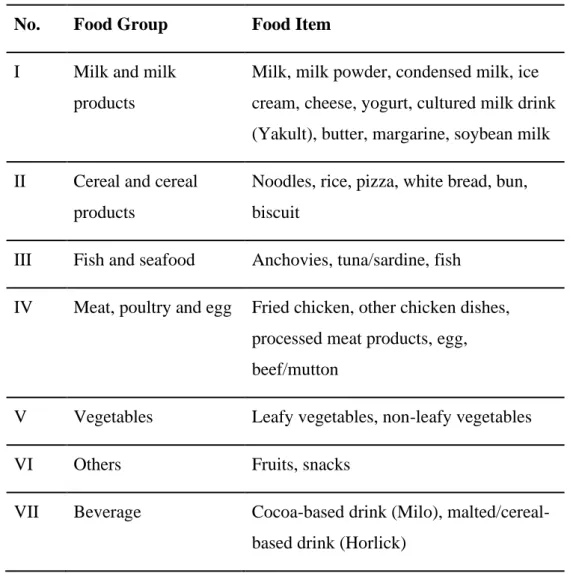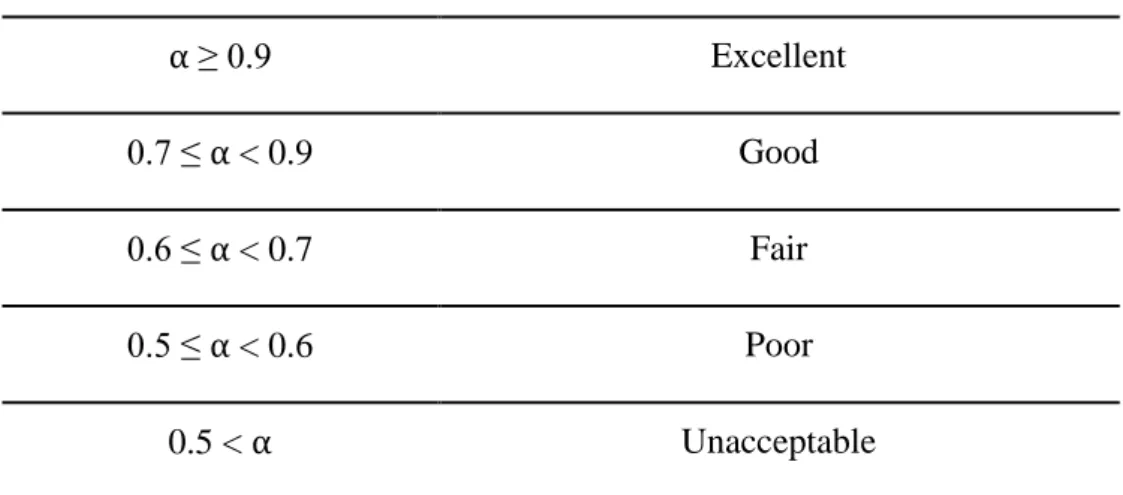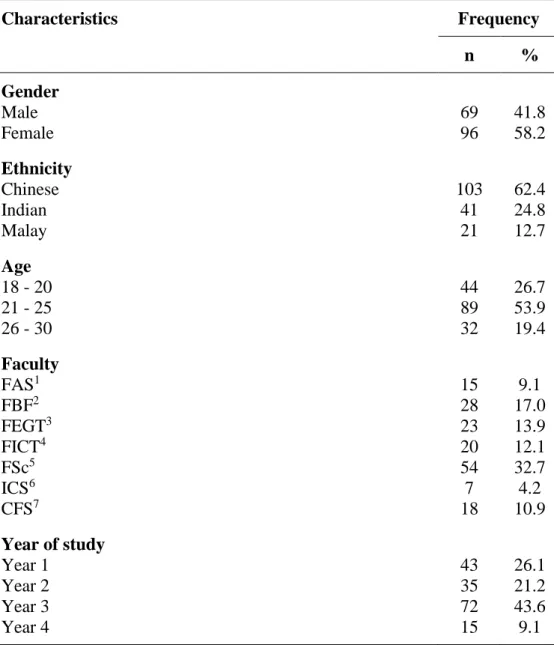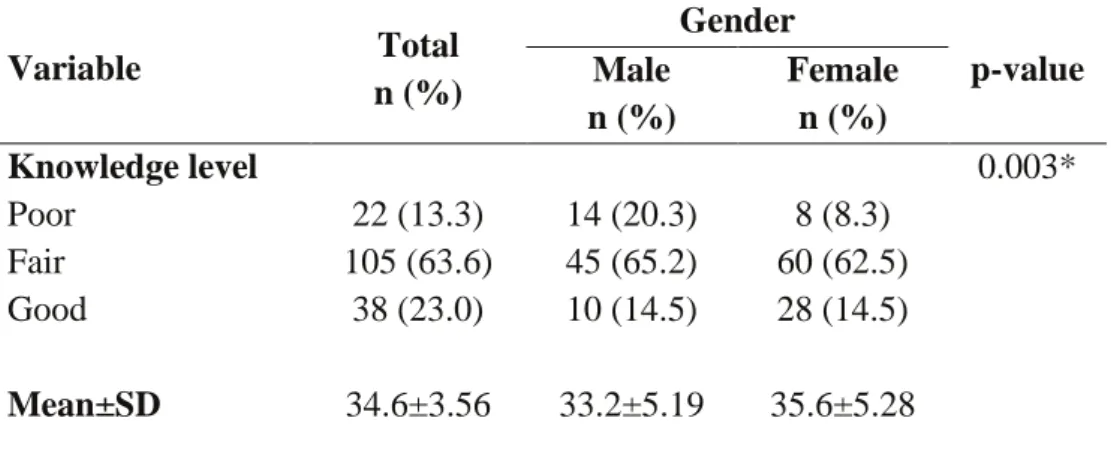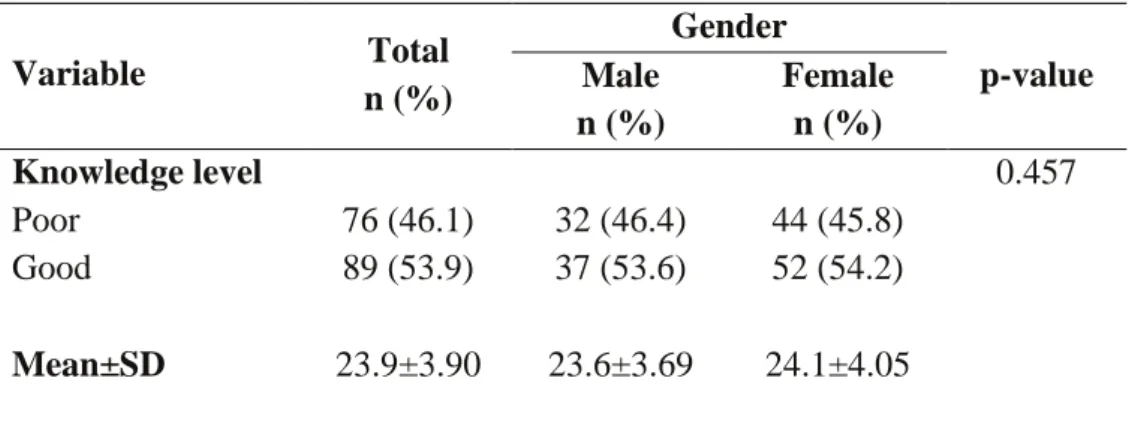KNOWLEDGE OF OSTEOPOROSIS AND CALCIUM AND ITS RELATIONSHIP WITH DIETARY CALCIUM USE AMONG STUDENTS AT TUNKU ABDUL RAHMAN UNIVERSITY (UTAR),. Pearson's correlation was to determine the relationship between osteoporosis knowledge, calcium knowledge and dietary calcium intake.
Chapter Overview
Research Background
2 Osteoporosis has been a global health concern for decades, affecting more than 200 million people worldwide (Kaushal et al., 2018). When an imbalance in bone turnover occurs, excessive bone resorption exceeds bone replacement, causing the bone to become more porous and brittle (Vannucci et al., 2018).
Problem Statement
On the other hand, a link has been found between nutritional knowledge and calcium intake (Nguyen and Murimi, 2021). Knowledge about osteoporosis was not investigated in this study. It did not assess respondents' average dietary calcium intake.
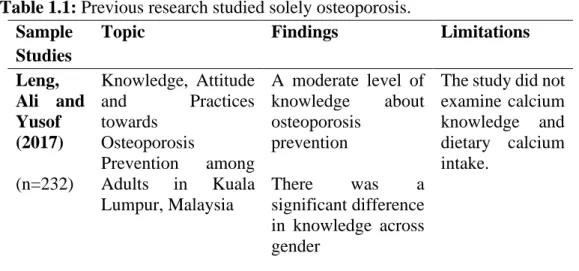
Research Objectives .1 General Objective
Specific Objectives
Is there a discrepancy in dietary calcium intake among different proficiency levels of UTAR students at Kampar campus. Is there a relationship between osteoporosis knowledge, calcium knowledge and dietary calcium intake among UTAR students in Kampar campus.
Hypothesis
Chapter Overview
Literature Review
- Global Osteoporosis Burden
- Hip Fracture Epidemiology in Malaysia
- Osteoporosis Knowledge
- Calcium Knowledge
- Dietary Calcium Intake
In general, inadequate calcium knowledge was observed among young adults, which was positively associated with low dietary calcium intake. Differences in dietary calcium intake between countries are likely due to different diets and dietary sources of calcium.
Conceptual Framework
This study describes the level of knowledge about calcium and osteoporosis so that health authorities can decide whether there is a need for further training or intervention. In addition, this study provides data on current dietary calcium intake among UTAR students, so it acts as an indicator of the future occurrence of bone diseases. In addition, this study may help dieticians recognize the trend of insufficient calcium intake among college students so that they can improve college students' calcium intake as an early prevention of bone disease.
Chapter Overview
Study Design
Sample Size
Inclusion and Exclusion Criteria
Research Instruments
- Section A: Socio-demographic Questionnaire
- Section B: Bone Health and Osteoporosis Knowledge Questionnaire Section B consisted of a validated questionnaire modified from prior research by
- Section D: Food Frequency Questionnaire
- Pilot Study
The purpose of this section was to assess the level of knowledge about bone health and osteoporosis among the respondents. The purpose of this section was to assess the level of calcium knowledge of the respondents. 22 FFQ, as they accounted for 90% of the calcium intake of the total population in the previous study.
For example, if the respondent consumed 1 glass of milk every day in the last month, they had to choose "1 glass a day". Then, the estimated average calcium intake was categorized with reference to the Recommended Nutrient Intake for Malaysian Adults (RNI, 2017) as shown in Table 3.5. In this study, the researcher conducted pre-testing to measure the reliability of a particular modification.
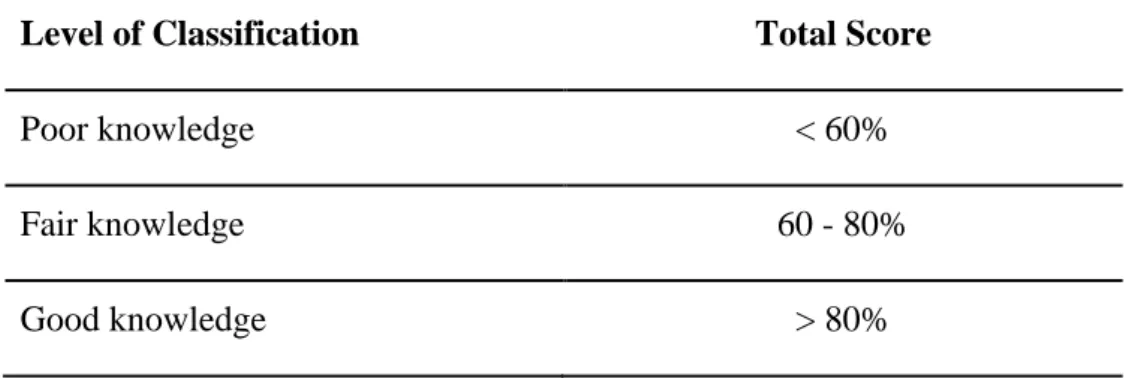
Data Collection
As a result, the bone health and osteoporosis questionnaire and the calcium knowledge questionnaire showed relatively reasonable and good internal reliability and consistency with a Cronbach's alpha value of 0.687 and 0.765, respectively. For dietary calcium intake, the estimated mean was calculated using Microsoft Excel (as shown in Appendix B). The skewness and kurtosis tests were also used to identify whether the variables were normally distributed.
One-way ANOVA test was conducted to determine the association between dietary calcium intake and knowledge of osteoporosis at three levels. Meanwhile, the association between dietary calcium intake and calcium knowledge was assessed at two levels using the Independent t-test. Furthermore, Pearson's correlation test was performed to measure the linear relationship between the three variables.
Chapter Overview
Background information
Sociodemographic Characteristics of Respondents
27 than a third of respondents (43.6%) were studying in their second year while completing the questionnaire. Finally, regarding personal history, most of the respondents (87.3%) did not experience fractures or had been diagnosed with osteoporosis prior to the research.
FBF 2
Osteoporosis Knowledge of Respondents
The individual score was generated after adding each of the scores obtained from three components, including general information, risk factors, and preventive behavior. The findings showed that the difference between sex and bone health knowledge was statistically significant with a p-value of 0.003. The results of bone health knowledge among the respondents are shown in Table 4.2 and Figure 4.1.
Based on Table 4.3, most of the participants (87.9%) understood that bone disorders are likely to occur during aging. Moreover, about one third of the respondents knew that osteoporosis condition can lead to tooth loss and fragility fractures (65.5%) as well as widow's hump (64.2%). Apart from that, a majority of students were well aware of the risk factors of osteoporosis in which age, family history and usual soft drink consumption take a relatively high frequency with and 62.4%, respectively.
Osteoporosis Knowledge of Respondents
30 lifestyle preventive behavior 81.8% of those questioned (n=135) were aware that consuming fish such as tuna and salmon could prevent the disease. However, more than half of the respondents did not know that osteoporosis could be prevented by increased vegetable intake (50.3%) and reduced meat and poultry intake (58.2%). Maximum bone mass is achieved during adolescence until young adulthood 103 62.4 Bone diseases are likely to develop during aging 145 87.9 Osteoporosis and osteoarthritis can be prevented during aging 102 61.8 Unlike osteoarthritis, osteoporosis may show no symptoms of osteoporosis 77 there are no symptoms of osteoporosis 77 humeroporosis . 106 64.2 A bone mineral density test can be used to diagnose osteoporosis 94 57.0.
Regarding general knowledge of calcium, most respondents (92.7%) know that calcium and vitamin D are important nutrients for bone health. Almost two-thirds of the students believed that calcium is obtained exclusively from food (66.1%) and that it is excreted daily through the skin, nails, hair and metabolic waste (63%). Regarding calcium intake, the majority of students were well aware of the purpose and nutritional sources of sufficient calcium intake, namely 87.9% and 86.1% of all respondents.
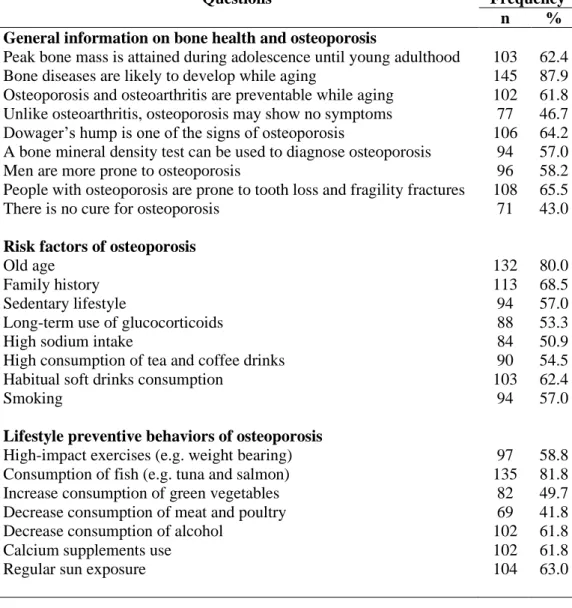
Calcium Knowledge of Respondents
Dietary Calcium Intake of Respondents
Based on the results in Table 4.6, almost all participants (92.7%) had a relatively low daily calcium intake, while the remaining 7.3% had an insufficient intake. None of the participants managed to get enough calcium, namely 1000 mg/day in the previous month. In addition, the study showed an average calcium intake of mg/day in the participants, which fell into the low category.
Dietary Calcium Intake of Respondents
DCI among Osteoporosis Knowledge Levels
Poor knowledge was defined as a total score of <60%, whereas fair knowledge was 60%–80% of the total score, and good knowledge was >80% of the total score. To examine whether levels of knowledge about osteoporosis influenced calcium intake, a one-way ANOVA test was performed. One-way ANOVA is used when there is one categorical independent variable and one quantitative variable, where the independent variable must have at least three levels.
Therefore, it was concluded that knowledge about osteoporosis played an important role in influencing calcium intake.
DCI between Calcium Knowledge Levels
Mean DCI by Osteoporosis Knowledge
Association between Osteoporosis Knowledge, Calcium Knowledge and Dietary Calcium Intake
The association between bone health knowledge, calcium knowledge, and calcium intake was determined using Pearson correlation analysis. Based on Table 4.9, Pearson's correlation coefficient showed a moderate positive correlation (r = 0.587) between osteoporosis knowledge and calcium knowledge with p-value <0.001. In addition, the results of Pearson's correlation coefficients indicated an association between knowledge and dietary calcium intake.
Therefore, it is assumed that better knowledge of osteoporosis will contribute to increased calcium intake. Similarly, calcium knowledge was found to be associated with dietary calcium intake with a moderate positive correlation coefficient (r=0.533, p<0.001). In general, it was reported that the higher the knowledge, the higher the calcium intake among the respondents.
Chapter Overview
Sociodemographic Characteristics
Osteoporosis Knowledge of Respondents
This may be justified as women may have better perceptions and awareness of osteoporosis as they are more prone to this disease (Chan et al., 2019). The observation paralleled several studies conducted among university students (Tayel et al. Al-Naggar et al., 2016). However, more than half of the respondents did not find that osteoporosis has no symptoms and treatment unlike osteoarthritis, similar to previous research (Chan et al., 2021).
Similar results obtained by Tayel et al. 2013) observed a lack of knowledge among Egypt students about these two specific risk factors. This finding was consistent with previous research conducted in Bangladesh and Nigeria (Uddin et al., 2013; Folasire and Akinrinde, 2017). Meanwhile, a local study among university students by Sham et al. 2013) revealed that a majority had low knowledge about dietary calcium intake, which contradicted the present findings.
Dietary Calcium Intake of Respondents
Commonly consumed calcium-rich breakfasts in Malaysians include breakfast cereals, hot or powdered drinks (e.g. Milo and Horlick) and high-fat milk (Mustafa et al., 2019). Therefore, the habit of skipping breakfast can directly decrease calcium intake. This could be justified as most of them were postmenopausal and more prone to osteoporosis, so they consumed more calcium (Chan et al., 2019). Consistent findings were observed among adults in Iran, indicating that those with higher levels of health literacy were less likely to consume fast food as they were aware of the effects of unhealthy diets on their health (Namdar et al., 2021).
The result supported previous local research by Sham et al. 2013) indicating that a majority of university students had low perception and intake of calcium at the same time, as evidenced by infrequent consumption of dairy products. 46 Taken together, these findings suggested that nutrition knowledge has a significant impact on diet quality (Geaney et al., 2015). A better understanding of nutrition can increase the perceived benefits of nutrients, further improving eating patterns (Salahshoori et al., 2014; Scalvedi et al., 2021).
Association between Osteoporosis Knowledge, Calcium Knowledge and Dietary Calcium Intake
Regarding the strengths of the study, the current study used validated questionnaires to assess osteoporosis knowledge, calcium knowledge, and dietary calcium intake among UTAR students at the Kampar campus. Future studies are recommended to determine the long-term cause-and-effect relationship between dietary calcium intake and osteoporosis knowledge and calcium knowledge. Regarding the difference between dietary calcium intake and knowledge level, those with good knowledge about osteoporosis had the highest calcium intake among the knowledge categories.
Similarly, students with good calcium knowledge had a higher calcium intake than those with poor knowledge. As recommendations, future research may explore other personal or environmental factors that influence dietary calcium intake among college students. Influence of educational sources on knowledge of osteoporosis and calcium intake in adult women: a cross-sectional study.
Title: Knowledge of Osteoporosis and Calcium and its Relation to Dietary Calcium Intake among Students at Universiti Tunku Abdul Rahman (UTAR), Kampar. This questionnaire aims to assess the knowledge of osteoporosis and calcium and its relationship with dietary calcium intake among UTAR students at Kampar campus.
Consumption of fish (eg tuna and salmon) Increase consumption of green vegetables Reduce consumption of meat and poultry Reduce consumption of alcohol. 99% of the body's total calcium is stored in bones Calcium must be obtained from the diet The lack of calcium in the diet causes our body to take calcium from the bones. In this section you will be asked about your usual eating habits during the past month.
Choose the option that best describes how often you eat a certain food. If you consumed one serving of milk once a week in the past month, enter "1" for "weekly" frequency. Meanwhile, if you haven't eaten a particular food in the past month, put "0" in "monthly".
